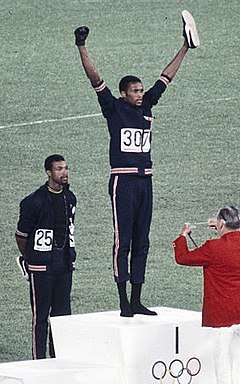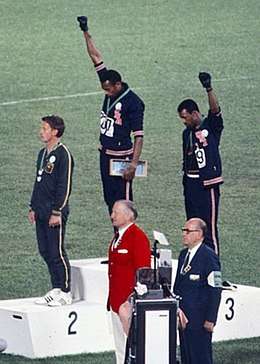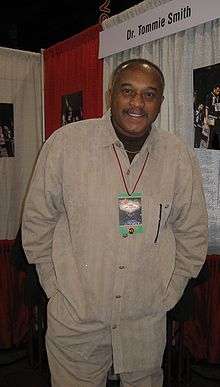Tommie Smith
Tommie C. Smith (born June 6, 1944)[3] is an American former track & field athlete and former wide receiver in the American Football League. At the 1968 Summer Olympics, Smith, aged 24, won the 200-meter sprint finals and gold medal in 19.83 seconds – the first time the 20-second barrier was broken legally. His Black Power salute with John Carlos atop the medal podium to protest racism and injustice against African-Americans in the United States caused controversy, as it was seen as politicizing the Olympic Games. It remains a symbolic moment in the history of the Black Power movement.
 John Carlos and Tommie Smith (center) at the 200 m award ceremony of the 1968 Olympics, wearing black gloves, black socks and no shoes | |||||||||||||||||||||||
| Personal information | |||||||||||||||||||||||
|---|---|---|---|---|---|---|---|---|---|---|---|---|---|---|---|---|---|---|---|---|---|---|---|
| Nationality | American | ||||||||||||||||||||||
| Born | June 6, 1944[1][2] Clarksville, Texas, United States[2] | ||||||||||||||||||||||
| Height | 6 ft 3 in (1.91 m)[2] | ||||||||||||||||||||||
| Weight | 185 lb (84 kg)[2] | ||||||||||||||||||||||
| Sport | |||||||||||||||||||||||
| Sport | Track and field | ||||||||||||||||||||||
| Event(s) | Sprints | ||||||||||||||||||||||
| College team | San Jose State Spartans | ||||||||||||||||||||||
| Club | Santa Clara Valley Youth Village[2] | ||||||||||||||||||||||
| Achievements and titles | |||||||||||||||||||||||
| Personal best(s) | |||||||||||||||||||||||
Medal record
| |||||||||||||||||||||||
| No. 24 | |||
|---|---|---|---|
| Position: | Wide receiver | ||
| Personal information | |||
| Height: | 6 ft 3 in (1.91 m) | ||
| Weight: | 190 lb (86 kg) | ||
| Career information | |||
| High school: | Lemoore (CA) | ||
| College: | San Jose State | ||
| NFL Draft: | 1967 / Round: 9 / Pick: 226 | ||
| Career history | |||
| Career NFL statistics | |||
| |||
| Player stats at PFR | |||
Early life and career
Tommie Smith was born on June 6, 1944, in Clarksville, Texas, the seventh of twelve children born to Richard and Dora Smith. He suffered from pneumonia as a child, but still grew to be an athletic youth. While attending Lemoore High School in Lemoore, California, Smith showed great potential, setting most of the school's track records, many of which remain. He won the 440-yard dash in the 1963 CIF California State Meet.[4] He was voted Lemoore's "Most Valuable Athlete" in basketball, football, and track and field,[5] and was also voted vice president of his senior class.[6] His achievements earned him a scholarship to San José State University.[7]
On May 7, 1966 while he was at San Jose State, Smith set a world best of 19.5 seconds in the 200m straight, which he ran on a cinder track.[8] That record for 200m was finally beaten by Tyson Gay on May 16, 2010, just over 44 years later,[9] though Smith still holds the record for the slightly longer 220-yard event. Since the IAAF has abandoned ratifying records for the event, Smith still retains the official record for the straightaway 200m/220 yards in perpetuity.[10]
A few weeks later, on June 11, 1966, Smith set the record for 200 meters and 220 yards around a turn at 20.0, the first man to do that in 20 seconds. Six days later he won the NCAA Men's Outdoor Track and Field Championship. Smith also won the national collegiate 220-yard (201.17 m) title in 1967 before adding the AAU furlong (201.17m) crown as well. He traveled to Japan for the 1967 Summer Universiade and won the 200m gold medal. He repeated as AAU 200m champion in 1968 and made the Olympic team.
1968 Summer Olympics
Leading up to the Olympics, at the U.S. Olympic Trials at Echo Summit, California, San Jose State teammate John Carlos beat Smith and his world record, running 19.92A. Carlos' record was disallowed because of the brush spike shoes he was wearing, as was a similar record by Vince Matthews in the 400 meters.[11]
As a member of the Olympic Project for Human Rights (OPHR) Smith originally advocated a boycott of the 1968 Mexico City Olympic Games unless four conditions were met: South Africa and Rhodesia uninvited from the Olympics, the restoration of Muhammad Ali's world heavyweight boxing title, Avery Brundage to step down as president of the International Olympic Committee (IOC), and the hiring of more African-American assistant coaches. As the boycott failed to achieve support after the IOC withdrew invitations for South Africa and Rhodesia, he decided, together with Carlos, to not only wear their gloves but also go barefoot to protest poverty, wear beads to protest lynchings, and wear buttons that said OPHR.[12]
At the 1968 Summer Olympics in Mexico, Smith nursed an injured hamstring into the 200m final. In the race, teammate Carlos powered out to the lead through the turn, while Smith got a slow start. Coming off the turn, Smith charged past Carlos and sped to victory. Knowing he had passed his training partner and closest foe, his victory was so clear, he raised his arms to celebrate 10m before the finish line. Still, he improved upon his own world record that would last for 11 years until Pietro Mennea would surpass it on the same track. Smith's time of 19.83 was among the first automatically timed world records for the event as recorded by the IAAF.[13]

Carlos and Smith made headlines around the world by raising their black-gloved fists at the medal award ceremony. Both athletes wore black socks and no shoes on the podium to represent African-American poverty in the United States. In support, Peter Norman, the silver medalist who was a white athlete from Australia, participated in the protest by wearing an OPHR badge.[14]
IOC president Avery Brundage deemed it to be a domestic political statement unfit for the apolitical, international forum the Olympic Games were intended to be. In response to their actions, he ordered Smith and Carlos suspended from the US team and banned from the Olympic Village. When the US Olympic Committee refused, Brundage threatened to ban the entire US track team. This threat led to the expulsion of the two athletes from the Games.[15]
A spokesman for the IOC said Smith and Carlos's actions were "a deliberate and violent breach of the fundamental principles of the Olympic spirit." Brundage, who was president of the United States Olympic Committee in 1936, had made no objections against Nazi salutes during the Berlin Olympics. He argued that the Nazi salute, being a national salute at the time, was acceptable in a competition of nations, while the athletes' salute was not of a nation and therefore unacceptable.[16]
Smith and Carlos faced consequences for challenging white authority in the U.S.[17] Ralph Boston, a black U.S. long jumper at the 1968 games, stated: "The rest of the world didn't seem to find it such a derogatory thing. They thought it was very positive. Only America thought it was bad."[17] The men's gesture had lingering effects for all three athletes, the most serious of which were death threats against Smith, Carlos and their families. Following their suspension by the IOC, they faced economic hardship.[17]
Smith stated in later years that "We were concerned about the lack of black assistant coaches. About how Muhammad Ali got stripped of his title. About the lack of access to good housing and our kids not being able to attend the top colleges."[18]
Athletics and later career

During his career, Smith set seven individual world records and also was a member of several world-record relay teams at San Jose State, where he was coached by Lloyd (Bud) Winter. With personal records of 10.1 for 100 meters, 19.83 for 200 and 44.5 for the 400, Smith still ranks high on the world all-time lists.
Smith, who had been drafted by the National Football League's Los Angeles Rams in the ninth round of the 1967 NFL Draft, signed to play for the American Football League's Cincinnati Bengals and was part of the team's taxi squad for most of three seasons as a wide receiver.[19] During the 1969 season, he played in two games, catching one pass for 41 yards.[20][21]
A year after his Olympic win, Smith finished his BA in Social Science at San Jose State University and went on to earn a master's in Social Change from Goddard College, whose program enabled Smith to integrate his teaching and writing practices into his coursework.[22][23]
After his track and football careers, he became a member of the United States National Track and Field Hall of Fame in 1978. In 1996, Smith was inducted into the California Black Sports Hall of Fame, and in 1999 he received that organization's Sportsman of the Millennium Award.[24] In 2000 and 2001 the County of Los Angeles and the State of Texas presented Smith with commendation, recognition and proclamation awards.[25]
He later became a track coach at Oberlin College in Ohio, where he also taught sociology and until 2005 was a faculty member teaching physical education at Santa Monica College in Santa Monica, California.[26]
Smith's autobiography, Silent Gesture, was published in 2007 by Temple University Press. In August 2008, he gave 2008 Olympic triple gold winner Usain Bolt of Jamaica one of his shoes from the 1968 Olympics as a birthday gift.[27]
In 2010, Smith put his gold medal and spikes up for auction. Bids started at $250,000, and the sale was scheduled to close November 4, 2010.[28] In 2013 Goddard College honored Smith as an alumnus by awarding him the Presidential Award for Activism in 2013.[23]
Recognition


Tommie Smith is featured in the 1999 HBO documentary Fists of Freedom: The Story of the '68 Summer Games. The documentary looks at events leading up to, during and after the Olympics, featuring interviews with Smith, Carlos and sociologist Harry Edwards, journalists and archival footage of the Games and the fallout after the raised fisted gloves by Carlos and Smith.
We were not Antichrists. We were just human beings who saw a need to bring attention to the inequality in our country. I don't like the idea of people looking at it as negative. There was nothing but a raised fist in the air and a bowed head, acknowledging the American flag – not symbolizing a hatred for it.[29]
For his lifelong commitment to athletics, education, and human rights, Smith received the Courage of Conscience Award from The Peace Abbey in Sherborn, Massachusetts.[30]
In 2004, was inaugurated in his presence in Saint-Ouen, France, a sports hall bearing his name.[31]
In 2005, a statue showing Smith and Carlos on the medal stand was constructed by political artist Rigo 23 and dedicated on the campus of San Jose State University.[32] Norman's Silver medal position was left vacant at his request, so visitors could pose for photos in solidarity with Smith and Carlos, as Norman had stood.[33]
A mural of the photo taken with Smith on the podium at the 1968 Olympics with Carlos and Norman was painted on the brick wall of a residence in Newtown, New South Wales, Australia, titled "Three Proud People Mexico 68". The house's owner, Silvio Offria, allowed an artist known only as "Donald" to paint the mural, and said that Norman came to Newtown to see the mural and have his photo taken with it before he died in 2006.[34] The mural faces the train tracks linking Sydney city to the Western and Southern Suburbs. In 2012, the Sydney City Council heritage listed the mural to safeguard it, after it had faced possible demolition in 2010 to make way for a railway tunnel.[35] Smith and Carlos were pallbearers at Norman's funeral in Melbourne in 2006.[34]
On July 16, 2008, Smith and Carlos accepted the Arthur Ashe Award for Courage for the salute at the 2008 ESPY Awards.[36]
In 2018, he received the Dresden Peace Prize. [37]
See also
- Timeline of the civil rights movement
- Bay Area Sports Hall of Fame
- Other American Football League players
- Men's 200 metres world record progression
Further reading
- Bates, Karen Grigsby (October 16, 2018). "50 Years Later, Raised Fists During National Anthem Still Resonate". Morning Edition. NPR.
- Brown, DeNeen (October 16, 2018). "'A cry for freedom': The Black Power salute that rocked the world 50 years ago". Washington Post.
- Barra, Allan. "Fists Raised, but Not in Anger" The New York Times, August 22, 2008
- Thomas, Katie. "For Australian Athletes, a Voice From the Grave" The New York Times May 23, 2008
- "In-flight film will urge Olympians to protest", The Daily Telegraph, May 24, 2008
- "Norman loses his spot in history", Sporting Life, October 17, 2005
- "Norman dies after heart attack", Fox Sports, October 3, 2006
- "Peter Norman, man on podium for Black Power salute, dies", USA Today, October 3, 2006
- Reed, Ron. "Norman to receive a final salute", The Herald Sun, October 6, 2006
- Hoy, Greg. "Fellow athletes pay tribute to Peter Norman", Australian Broadcasting Corporation, October 10, 2006
- Blackistone, Kevin B., The Dallas Morning News, August 23, 2008 (Archived original "'68 protest more than a memory" at the Wayback Machine (archived July 1, 2001))
- "Peter Norman dies after heart attack", The Age, October 3, 2006
- "Bitter price of Olympics' iconic image", Sydney Morning Herald, October 17, 2003
- Wise, Mike. "Clenched Fists, Helping Hand", The Washington Post, October 5, 2006
- "Norman Remembered as an Unflinching Champion", The Australian, October 9, 2006
- "Carlos, Smith act as pallbearers at funeral of podium mate from 1968 Olympics" at the Wayback Machine (archived March 11, 2007), MSNBC, October 9, 2006 (Archived original)
- Rees, Margaret "Australian athlete supported American civil rights struggle", World Socialist Web Site, October 23, 2006
References
- "Tommie SMITH | Profile". iaaf.org. IAAF. Retrieved January 1, 2019.
- "Tommie Smith Bio, Stats, and Results". sports-reference.com. Sports Reference. Archived from the original on April 17, 2020. Retrieved January 1, 2019.
- Silent Gesture: the autobiography of Tommie Smith (2007). Tommie Smith and David Steele. Temple University Press. p42.
- "California State Meet Results – 1915 to present". Hank Lawson. Archived from the original on October 6, 2014. Retrieved December 25, 2012.
- "Tommie's Bio". TommieSmith.com. Archived from the original on March 26, 2013. Retrieved March 6, 2013.
- Silent Gesture: the autobiography of Tommie Smith (2007). Tommie Smith and David Steele. Temple University Press. p70.
- Tommie Smith Archived October 4, 2009, at the Wayback Machine, Spartacus Educational
- Tyson Gay aims for Tommie Smith's 44-year-old record . BBC Sport (April 30, 2010). Retrieved on May 3, 2010.
- Oddi, Vicky (May 16, 2010) Gay sprints to 19.41 world best on 200m straight. USATF Press release. Retrieved on June 13, 2015.
- Edwards Announces Retirement Archived February 27, 2012, at the Wayback Machine. Track and Field News. Retrieved on June 13, 2015.
- http://www.puma-catchup.com/the-forbidden-shoe/
- Zirin, Dave. Resistance: the best Olympic spirit
- Hymans, Richard; Matrahazi, Imre (2015). Progression of IAAF World Records. 2015 Edition (PDF). Monaco: IAAF Athletics. p. 45.
- Haddow, Joshua. "We Interviewed Tommie Smith About the 1968 'Black Power' Salute". Vice.com. Retrieved March 6, 2013.
- On This Day: Tommie Smith and John Carlos Give Black Power Salute on Olympic Podium. Findingdulcinea.com. Retrieved on June 13, 2015.
- "The Olympic Story", editor James E. Churchill, Jr., published 1983 by Grolier Enterprises Inc.
- "The Silent Salute 1968 Olympics". (2016). Pitch International LLP.
- "Smith: 'They tried to make it a moment, but it was a movement'".
- Moore, Kenny (August 5, 1991) . Sports Illustrated
- Tommie Smith, WR at. Nfl.com. Retrieved on June 13, 2015.
- Tommie Smith NFL & AFL Football Statistics. Pro-Football-Reference.com.
- Davis, David (August 2008). "Olympic Athletes Who Took a Stand". Smithsonian. Retrieved March 29, 2018.
- Bodette, Mitch Wertlieb, Melody (October 3, 2013). "Olympian Tommie Smith To Be Honored By Goddard". Retrieved March 29, 2018.
- "Chat with Tommie Smith". ESPN. Retrieved July 10, 2017.
- "Tommie Smith : California Sports Hall of Fame". California Sports Hall of Fame. Retrieved March 29, 2018.
- "THE LEGENDARY TOMMIE SMITH RETIRES FROM SMC AFTER 27 YEARS:". Santa Monica Mirror. Retrieved December 11, 2018.
- Time To Dance: Usain v Asafa, Puma, August 25, 2008, archived from the original on April 28, 2010CS1 maint: unfit url (link)
- "Tommie Smith selling '68 gold medal". espn.com. Retrieved October 14, 2010.
- Roy, George (Director) (1999). Firsts of Freedom: The Story of the '68 Games (documentary).
- The Couage of Conscience Award, The Peace Abbey, archived from the original on February 14, 2009, retrieved August 22, 2008
- Johnson, Rafer (2009). Great Athletes. Salem Press. ISBN 9781587654862. Retrieved July 10, 2017.
- Crumpacker, John (October 18, 2005), OLYMPIC PROTEST: Smith and Carlos Statue captures sprinters' moment, San Francisco Chronicle, retrieved August 22, 2008
- Gazzaniga, Riccardo. "The White Man in That Photo". Films For Action. Retrieved July 14, 2016.
- Tovey, Josephine (July 27, 2010). "Last stand for Newtown's 'three proud people'". The Sydney Morning Herald.
- Campion, Vikki (July 24, 2012). "Graffiti granted wall of protection in Sydney". The Daily Telegraph. Retrieved January 1, 2014.
- "Olympics Black Power Heroes Are Still Waiting for an Apology". The Daily Beast. Retrieved April 6, 2017.
- "Speech Tommie Smith". Dresden-Preis. Retrieved December 11, 2018.
External links
| Wikimedia Commons has media related to Tommie Smith. |
- Official website
- Tommie Smith at World Athletics
- Tommie Smith at the International Olympic Committee
- Tommie Smith at the U.S. Olympic & Paralympic Hall of Fame
Videos
- Tommie Smith wins the 1968 Olympics men's 200 meters final in 19.83 seconds via Team USA on YouTube
- Tommie Smith on his 1968 Olympics gold medal and black power salute via Team USA on YouTube
| Records | ||
|---|---|---|
| Preceded by |
Men's 200 meters world record holders October 16, 1968 – September 12, 1979 |
Succeeded by |
| Achievements | ||
|---|---|---|
| Preceded by |
Men's 200 meters season's best 1965 – 1968 |
Succeeded by |
